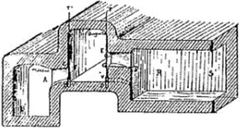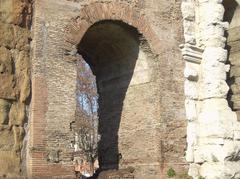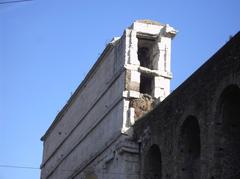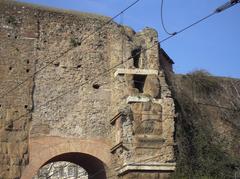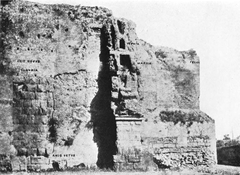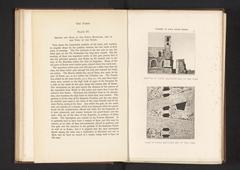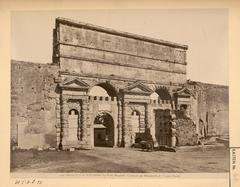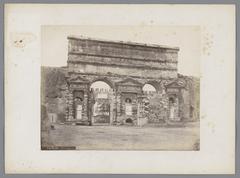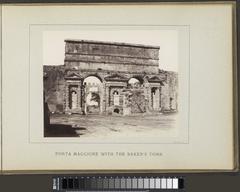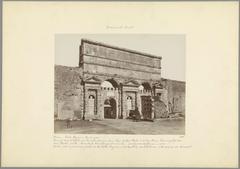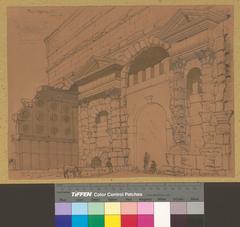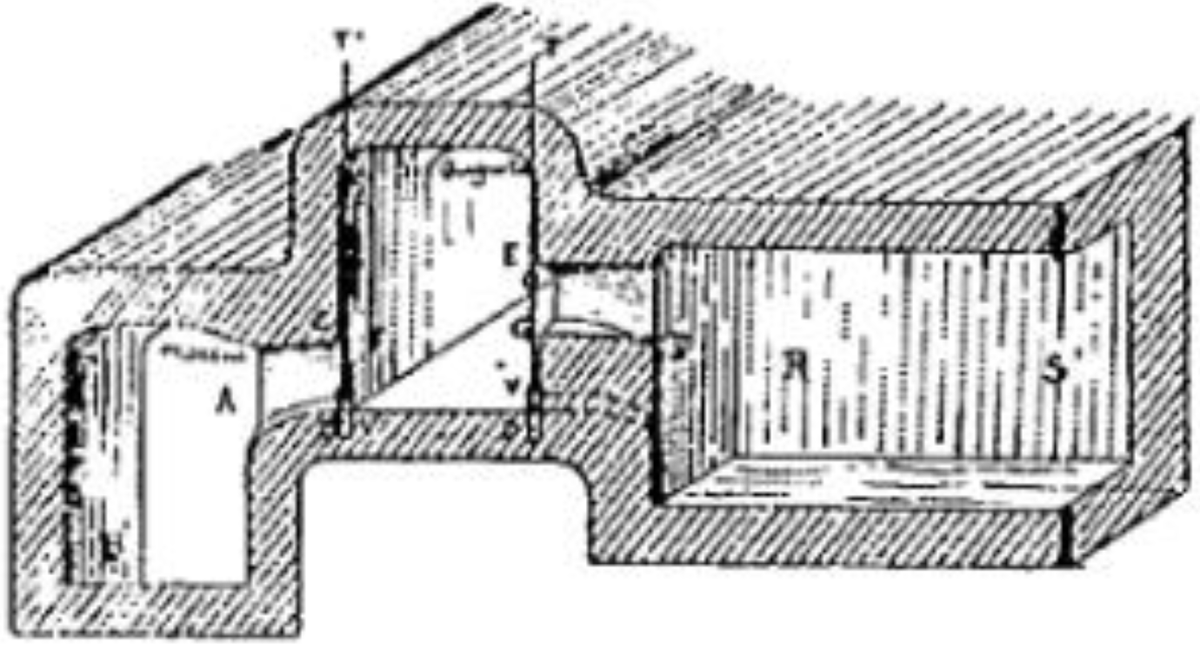
Porta Maggiore Rome: Visiting Hours, Tickets & Historical Sites Guide
Date: 14/06/2025
Introduction
Porta Maggiore is one of Rome’s most remarkable ancient monuments, combining imperial engineering, urban planning, and centuries of cultural evolution. Originally constructed in the 1st century CE, this monumental double arch has served as both a vital aqueduct conduit and a fortified city gate. Today, Porta Maggiore stands as a testament to Rome’s ingenuity, accessible to visitors eager to explore its history, architecture, and enduring significance.
This comprehensive guide offers detailed information on Porta Maggiore’s origins, architectural features, urban and cultural context, visitor logistics—including hours, tickets, accessibility, and transportation—and practical tips to ensure an enriching visit.
Table of Contents
- Origins and Early Construction
- Transformation into a City Gate
- Architectural Features and Inscriptions
- Urban and Cultural Significance
- Visitor Information
- Visitor Experience and Practical Tips
- Frequently Asked Questions (FAQ)
- Conclusion
- Call to Action
- References
Origins and Early Construction
Porta Maggiore, originally known as Porta Praenestina, was built in 52 CE under Emperor Claudius. Its primary function was to support two of Rome’s major aqueducts—the Aqua Claudia and the Anio Novus—carrying water into the city and demonstrating Roman engineering mastery. The structure, crafted from massive blocks of white travertine, spanned the ancient Via Praenestina and Via Labicana, allowing both water and road traffic to enter Rome (Madain Project; Wikipedia; A View on Cities).
Transformation into a City Gate
In the late 3rd century CE, as external threats increased, Emperor Aurelian incorporated Porta Maggiore into the new Aurelian Walls, transforming it into a city gate. This adaptation is a striking example of Roman practical ingenuity, as a structure built for water supply was seamlessly integrated into military defenses (Aurelian Walls). Later, Emperor Honorius reinforced the walls and added further defensive elements in the early 5th century (A View on Cities).
Architectural Features and Inscriptions
Porta Maggiore’s design is characterized by its monumental double arches—each approximately 14 meters wide and 8 meters high—supporting two levels of aqueduct channels (Wikipedia). The travertine blocks are rusticated, giving the gate a robust, textured appearance. Above the arches, three large inscriptions commemorate Emperor Claudius, as well as Emperors Vespasian and Titus for their later restorations. These inscriptions, in elegantly carved Roman capitals, served to reinforce imperial prestige and the importance of public works (Porta Maggiore Inscriptions; Italy Guides).
Urban and Cultural Significance
Strategically located at the crossroads of the Via Praenestina and Via Labicana, Porta Maggiore was a major gateway for travelers, merchants, and pilgrims entering Rome. Its proximity to the Tomb of Marcus Vergilius Eurysaces—a unique funerary monument honoring a prosperous freedman baker—adds to the area’s rich cultural tapestry (Sooners in Rome; The Brain Chamber). The gate’s enduring presence as an urban landmark reflects Rome’s long history as a center of commerce, movement, and exchange.
Today, Porta Maggiore remains embedded in the city’s vibrant urban life, surrounded by tram lines, buses, and a multicultural neighborhood. The juxtaposition of ancient stonework with the pulse of modern Rome highlights the city’s dynamic continuity (Understanding Rome).
Visitor Information
Visiting Hours
Porta Maggiore is an open-air monument accessible 24 hours a day, seven days a week. For safety and optimal viewing, daylight visits are recommended (Evendo; Italy Guides).
Tickets and Admission
No ticket is required. Admission is completely free as the monument is integrated into the city’s public space (Rome’s Ancient Gates).
Accessibility
The monument is generally accessible, with paved walkways around the structure. Some nearby sidewalks may be uneven, and the surrounding area is a busy traffic intersection, so visitors should exercise caution, especially those with mobility challenges.
Guided Tours
While there is no official visitor center, Porta Maggiore is featured in many walking tours focused on Rome’s ancient walls, aqueducts, and lesser-known sites. Guided tours can be booked through local operators or online platforms, providing in-depth historical context (Evendo).
Getting There
- Tram: Lines 3 and 19 stop directly at Piazza di Porta Maggiore.
- Bus: Multiple city buses serve the area, with connections to Termini Station and other districts.
- Metro: The nearest metro station is Manzoni (Line A), about a 10-minute walk away. Termini Station is also within walking distance.
Best Time to Visit
Early morning or late afternoon offers the best lighting for photography and a quieter atmosphere. Avoid peak traffic hours for a more relaxed experience.
Nearby Attractions
- Tomb of Marcus Vergilius Eurysaces: Adjacent to the gate, this distinctive monument illustrates ancient Roman social mobility and funerary art (Turismo Roma).
- Basilica di Santa Croce in Gerusalemme: An important pilgrimage church within walking distance.
- Basilica di Santa Maria Maggiore: One of Rome’s principal churches, also nearby.
- San Lorenzo District: Renowned for its vibrant nightlife and street art.
- Esquilino District: Offers multicultural markets and eateries.
Visitor Experience and Practical Tips
- What to See: Explore the imposing arches, view the original aqueduct channels, and examine the Latin inscriptions. Visit the adjacent Tomb of Eurysaces for a glimpse into ancient Roman life.
- Travel Tips: Use pedestrian crossings and stay aware of traffic. Wear comfortable shoes for walking on uneven surfaces. Consider combining your visit with trips to nearby attractions for a broader experience.
- Facilities: There are no onsite restrooms or visitor centers. Cafes and shops are available in the surrounding neighborhood.
Frequently Asked Questions (FAQ)
Q: What are Porta Maggiore’s opening hours?
A: Porta Maggiore is accessible at all times, though daylight visits are recommended for safety and better viewing.
Q: Is there an entrance fee?
A: No, visiting Porta Maggiore is free of charge.
Q: How do I get to Porta Maggiore by public transport?
A: Take tram lines 3 or 19, city buses, or the metro to Manzoni station and walk about 10 minutes.
Q: Are guided tours available?
A: Yes, many walking tours of Rome include Porta Maggiore. Booking in advance is recommended.
Q: Is the site accessible to people with disabilities?
A: The area is generally accessible, but caution is needed due to uneven sidewalks and traffic.
Conclusion
Porta Maggiore is a unique intersection of ancient engineering and urban vitality, exemplifying Rome’s ability to adapt and repurpose monumental infrastructure. As both a symbol of imperial power and a living part of the city, it offers visitors a chance to experience the layers of history that define the Eternal City. With free access, excellent public transport connections, and proximity to other historical sites, Porta Maggiore is a must-see destination for anyone interested in Rome’s enduring legacy.
Call to Action
Plan your visit to Porta Maggiore and immerse yourself in the history and culture of Rome beyond the usual tourist routes. For more guides, tips, and expert insights, download the Audiala app and follow us on social media for real-time updates and exclusive content about Rome’s ancient monuments.
References
- Madain Project: Porta Maggiore
- Wikipedia: Porta Maggiore
- A View on Cities: Porta Maggiore
- Rome’s Ancient Gates
- Italy Guides: Porta Maggiore
- Aurelian Walls - Rome Art Lover
- Tomb of Eurysaces - Rome Art Lover
- Porta Maggiore and Tomb of Marcus Vergilius Eurysaces - Turismo Roma
- Sooners in Rome: Past vs Present Porta Maggiore
- Evendo - Porta Maggiore Attraction
- The Brain Chamber: Porta Maggiore
- Rome Tourism Website
- Jubilee 2025 Transport Updates
- Understanding Rome: Porta Maggiore
- Kooloader: Porta Maggiore
